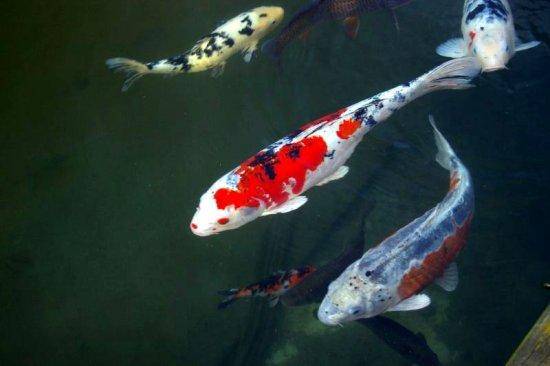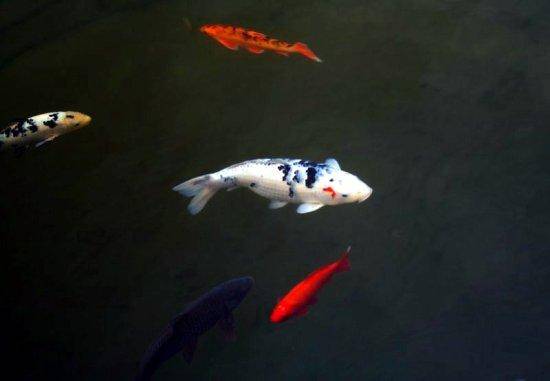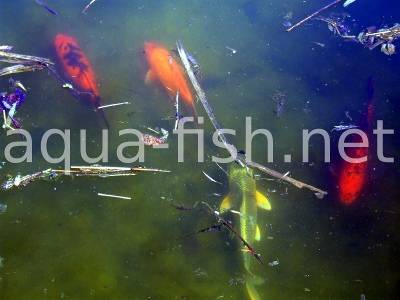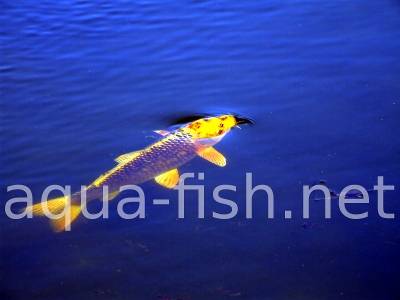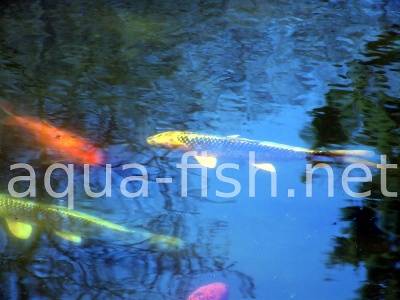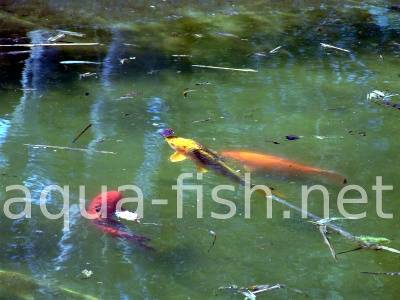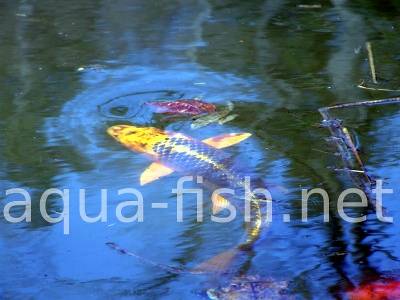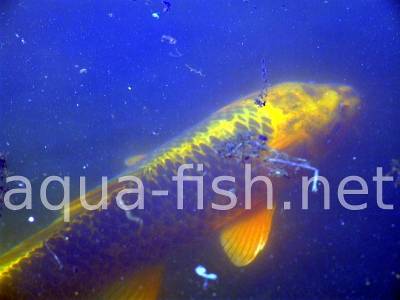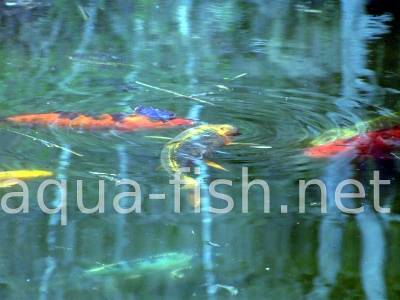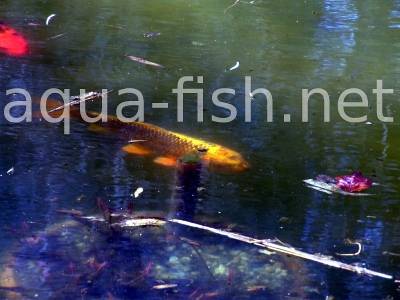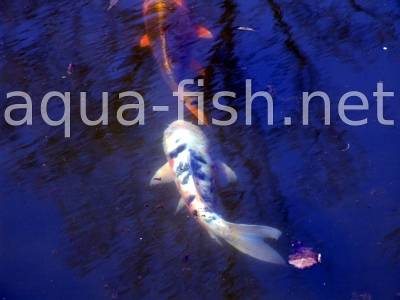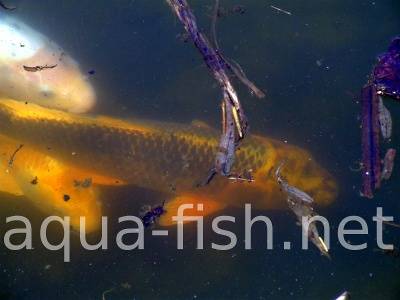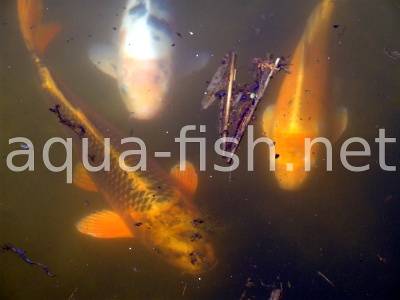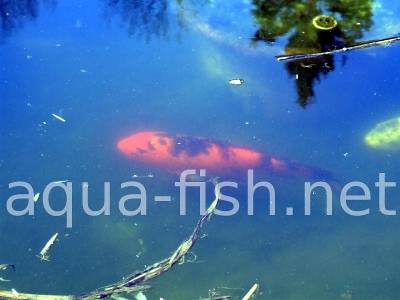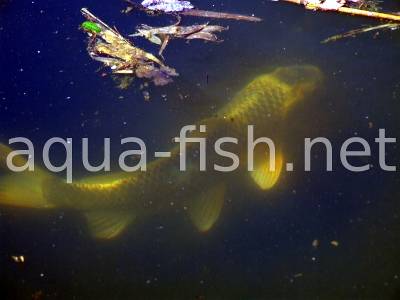Care of Koi Carps, types of Koi's & forum
Quick links - Answers
Brief Description
This article explains how to care for Koi's, offers forum for sharing experiences, and contains pictures of Koi carps. You should also visit the following page: Koi Carp profile which contains comments by fish keepers and briefly summarizes recommended care. We'd love to hear about your Koi's, so leave a message at the bottom of this page once you're done reading!
Introduction
Koi carp is an ornamental mutation of the common carp (Cyprinus carpio), native from Asia, especially China and Japan. Koi carp may look like a big goldfish, anyway you can distinguish it for it’s barbels at the sides of the mouth and for it’s size, an adult Koi can reach 30 inches (75cm).
Japanese breeders have selected a great number of colour varieties during years. The most common in shops are:
-
Kohaku
These are white Koi with red spots. Red and white colours are uniform, without shadings; Red spots should cover the half of the body.
-
Sanke
Red and black spotted white Koi. Red and black colours do not have shadings. The head must have only red spots (like Kohaku).
-
Shusui
Blue grey Koi with dark blue shadings on the lateral and dorsal lines, red colour on sides, fins and tail.
-
Asagi
Blue grey Koi with red orange shadings on the sides, fins, and tail.
-
Showa
Three coloured Koi. Looks like Sanke, but the black colour is more present, even on the head, and covers a big part of the body. Black stripes can be present on the fins and tail.
-
Bekko
White, red, or yellow Koi with black spots. Shiro Bekko has white body, Ki Bekko has yellow body, Aka Bekko has red body.
-
Utsurimono
Black Koi with red, yellow, or white spots. It can be considered as Bekko by mistake, but the main difference is that black colour on Utsurimono covers the most of the body. Ki Utsuri is black with yellow markings, Hi Utsuri has black body and red markings, Shiro Utsuri has black body and white spots.
There are other colour varieties, not really known, or present in shops, that are:
- Karasugoi (black with orange belly)
- Kigoi (yellow body)
- Benigoi (totally red body)
- Chagoi (light brown body)
- Shiro muji (totally white body)
- Soragoi (blue grey body)
Aquarium and pond
To use an aquarium for Koi carp is not a good decision. Since they grow fast and become really big, aquariums are suitable only until the fish reaches 6 – 9 inches (15 – 20 cm); so before buying be sure you will be able to provide a pond for them.
Koi live without problems in a temperature range from 34°F – 68°F (1°C – 20°C), so it is important to provide a deep pond to avoid total icing of water, and not to put the pond under direct sunlight, or summer would be too hot.
Summer, despite the higher temperature is the best season for Koi. During this time both, their metabolism and immune system work better. You can provide more food during this season to let them ready for winter; anyway do not overfeed or you risk to pollute the water; remember also that during summer there is a big amount of insects and Koi will eat them too. Water pollution is a big problem during summer because during this period, water is low oxygenated due to warmer temperature; use a powerful filter, and add clean water more often.
During fall you have to start to take care of your fish and pond to be ready for winter. As I said before, Koi can live in cold water without problems, anyway keep your fish controlled and in case you see a fish too stressed or lethargic, it is better to put it in a separated tank for winter, with a controlled temperature range around 60°F (15°C). When temperature goes under 50°F (10°C) stop feeding your fish, because they can not digest any food, since the metabolic system is almost stopped. Remember to keep the pond clean from fallen leafs, dead plants, and other things that can decompose in water.
If you live in cold places where temperatures get under 32°F (0°C) set up a repaired winter tank for your fish. Even if Koi can survive under frozen surface, it is better not to risk. Keep the filter turned on in winter too, so the water will not ice and there will be a gas exchange, so your Koi can have more oxygen, while do not add salt to avoid water icing.
After winter, spring is a difficult period, because temperature fluctuates a lot and this can make Koi more sensitive to illness. When the temperature has been above 50°F (10°C) for some days you can feed your fish again. In case you see them searching for food under the water surface, give them some small amount of food rich in wheat germ, that is highly digestible.
Koi are omnivorous so they need both an amount of protein and carbohydrates in their diet. You can feed them daily and more times in a day during warmest periods. A good quality of dry Koi fish food can be the base of the diet; then you can add insects, meal worms, earth worms, small pieces of freshwater fish. Koi eat also fruit and vegetables, so you can offer them cut in small pieces; Koi fish like lemons, oranges, grapefruit, watermelon, apples, carrots and more.
Choose food enriched with vitamin C, this helps their immune system to get ready for cooler times. Use food rich in fibre, like wheat germ for cold season, this make their intestine cleaner. Avoid fish food thought for other fishes.
Breeding
Koi carp reaches sexual maturity at the age of two years, when they are about 14 inches (35 cm) long.
There are some differences between males and females:
- the female is bigger than the male
- female’s body is fatter, because she carries eggs
- male’s fins are smaller and edged, while female’s fins are bigger, rounded and less coloured.
Koi usually breed in early summer, when the water temperature is around 68°F (20°C), they leave eggs on the ground and usually all the fish breed together; this generates healthy fish due the poor risk of inbreeding. Anyway if you want colourful fish, you should separate in a tank two males with two or three females of the same colour; you can also plan to make a pond with Koi of the same colour variety.
Breeding directly inside the pond will make the most of eggs and fry end up eaten by adult Koi. Provide a lot of hidden places, like high vegetation so some fry will be able to grow.
Copyright note: This article is originally written by Michela Ferretti. Aqua-fish.net owns the full copyright of this article.
Questions and answers
The following questions were added here on March 24th 2011 due to merging aqua-fish.net/answers with related articles. You're welcome to submit your own questions as long as they're unique and not yet answered on this page; Use a form that can be found at the bottom of this page for this purpose!
-
When do Koi fry start to show their colors?
Answer: This can vary a lot with different species and even individual fish but the average time is 6 months.
-
Where do Koi lay their eggs?
Answer: Koi will lay their eggs in plants, and they will begin breeding when they are 8-12 inches long.
-
Which fishes easily live with koi carp?
Answer: Goldfish can live with Koi because they are both coldwater fish. Other fish are capable of living with koi if they can adapt to the cooler water temperatures that koi need for optimum health.





